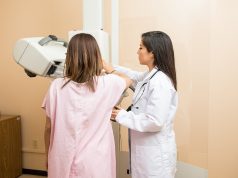The 104th Scientific Assembly and Annual Meeting of the Radiological Society of North America
The annual meeting of the Radiological Society of North America was held from Nov. 25 to 30 in Chicago and attracted approximately 55,000 participants from around the world, including radiologists, radiation oncologists, physicists in medicine, radiologic technologists, and other health care professionals. The conference featured scientific papers covering the newest trends in radiological research, as well as educational courses and informatics exhibits.
In one study, Kenneth R. Tomkovich, M.D., of the CentraState Medical Center in Freehold, New Jersey, and colleagues found cryoablation to be effective in treating early, low-risk breast cancer.
“This is the first-of-its-kind, multicenter trial in humans with cryoablation for treatment of breast cancer without surgical resection,” Tomkovich said. “Patients underwent this procedure wide awake using ultrasound guidance through a 5-mm incision and only local anesthesia in about an hour.”
Patients in the trial included women ages 60 years and older with 1.5-cm-or-less, low-grade, stage-1 breast cancers. The investigators followed patients for signs of recurrence with imaging only, primarily mammograms.
“There is an excellent safety profile with this procedure with no serious adverse events. There was 100 percent procedural success in 190 ablation procedures. Out of all patients, 107 with at least one-year follow-up, there have been only two cases of local recurrence or over a 98 percent success rate. The patients are scheduled to be followed for five years,” Tomkovich said. “The potential impact is … to change our thinking about breast cancer by providing a new image-guided outpatient treatment option for women with small, low-grade breast cancers.”
In another study, Edwin A. Takahashi, M.D., of the Mayo Clinic in Rochester, Minnesota, and colleagues aimed to gain insight into what happens to fat and muscle after left gastric artery embolization.
“We wanted to determine how much fat and lean muscle [patients] could potentially lose after the procedure. The patients in this study were those who were treated for gastric bleeding, not for weight loss, but the same artery (the left gastric artery) was embolized with similar technique as the bariatric embolization procedure,” Takahashi said. “The weight loss, fat loss, and muscle loss in our study were unintentional. We found patients lost a greater percentage of muscle than fat in the short term, which stresses the importance of nutritional monitoring and exercise after the procedure to mitigate muscle loss.”
Cyrus A. Raji, M.D., Ph.D., of the Mallinckrodt Institute of Radiology at the Washington University School of Medicine in St. Louis, and colleagues found that diffusion tensor magnetic resonance imaging (MRI) adds value for predicting Alzheimer’s dementia.
“Diffusion tensor imaging, an advanced MRI method that allows for quantification of white matter structure, predicted persons who will have Alzheimer’s dementia with 89 to 95 percent accuracy in 30 persons who were initially cognitively normal but then became demented over the course of 2.6 years on average, compared to 31 cognitively normal persons who remained normal,” Raji said.
According to Raji, this accuracy was better than the 78 percent accuracy for the Mini-Mental State Examination, a common pencil and paper test of cognitive function available at most doctors’ offices, and it was better than the 71 percent accuracy for the APOE-risk allele.
“Future studies are required to replicate these results, but this work will eventually form the basis for applying quantitative MRI for personalized risk prediction for Alzheimer’s,” Raji said.
RSNA: Mammography May Benefit 30-Year-Olds With Risk Factors
WEDNESDAY, Nov. 28, 2018 (HealthDay News) — Women with one of three breast cancer risk factors may benefit from mammography screening beginning at age 30, according to a study presented at the annual meeting of the Radiological Society of North America, held from Nov. 25 to 30 in Chicago.
RSNA: Refractory Back Pain Responds to CT-Guided Pulsed RF
TUESDAY, Nov. 27, 2018 (HealthDay News) — Computed tomography-guided pulsed radiofrequency is effective for patients with acute or subacute neuroradicular low back pain that is refractory to usual care, according to a study presented at the annual meeting of the Radiological Society of North America, held from Nov. 25 to 30 in Chicago.
RSNA: Mammography Has Value in Women Age 75 or Older
WEDNESDAY, Nov. 21, 2018 (HealthDay News) — Women aged 75 years and older can still benefit from routine mammography, with a cancer detection rate of 8.4 per 1,000 exams, according to a study scheduled to be presented at the annual meeting of the Radiological Society of North America, held from Nov. 25 to 30 in Chicago.
RSNA: Ultrasound of Shoulder Muscle May Help Diagnose T2DM
TUESDAY, Nov. 20, 2018 (HealthDay News) — The ultrasound appearance of an echogenic deltoid muscle may predict diabetes and prediabetes, according to a study scheduled to be presented at the annual meeting of the Radiological Society of North America, held from Nov. 25 to 30 in Chicago.
Copyright © 2018 HealthDay. All rights reserved.







